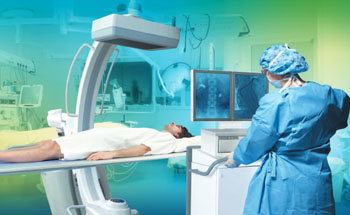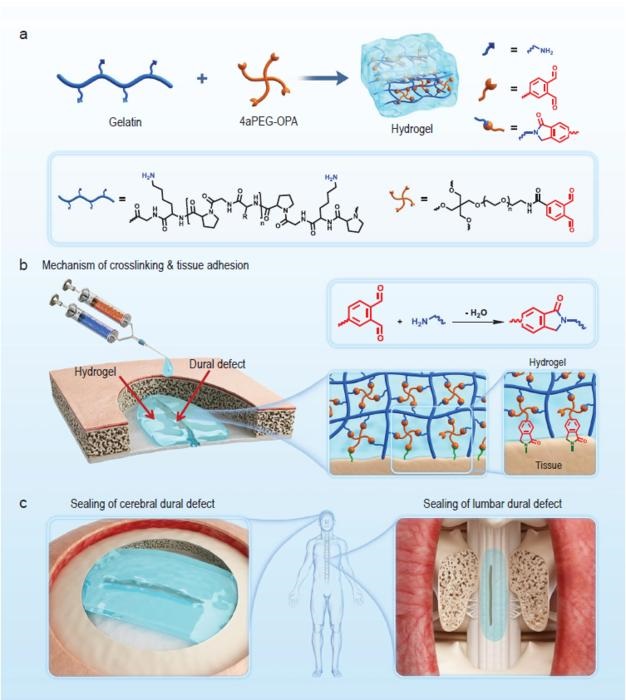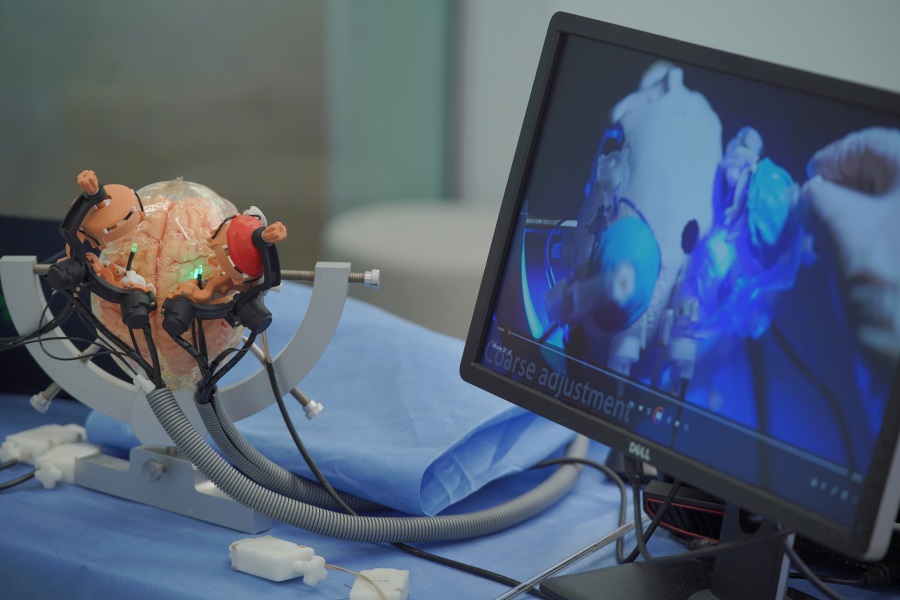Helping Optimize Workflow with Flat Panels in Surgery
|
By HospiMedica International staff writers Posted on 15 Mar 2016 |

Image: The Pixium Surgical Imaging Suite (Photo courtesy of Thales).
The year’s European Congress of Radiology (ECR) was a prime opportunity for Thales (Neuilly sur Seine, France), the French multinational electronic systems company, to introduce its groundbreaking flat panel detectors and imaging solutions to radiology professionals gathered to learn more about state of the art technologies on offer this year.
Jerome Tabourel, Marketing Director from Medical Radiology at Thales explained that at ECR, they were introducing a complete new product range for surgical applications. Hospital operations are evolving, he said, and the new emerging driver is the need for complementary products that help optimize workflow management.
“Currently, the surgical market uses imaging intensifiers and in this respect Thales holds 50% market share. But now we are seeing a transition between imaging intensifiers and flat panel detectors,” he noted.
With digital imaging and flat panel technology becoming ever more ubiquitous, the key global driver remains higher image quality with lower dose. At ECR, Thales unveiled its Pixium Surgical Imaging Suite that combines the high performance Pixium Surgical flat panel detectors with cutting-edge Image Chain Solution.
The surgical market is extremely price demanding, Mr. Tabourel pointed out. “Basically we are introducing the 21 cm by 21 cm squared flat panel to replace the 9 inch tubes, and we are introducing the 30 cm by 30 cm panel to replace the 12 inch tubes.” In coming months, the company will launch a third product in the series of flat panel detectors.
“Through an imaging chain solution we want to help our customers. It’s a software option that provides all the image processing at the level of surgical processing but it does not manage the interface with the system,” said Mr Tabourel.
“These products will bring outstanding image quality in terms of processing, and compactness and this is a trend which over time will see flat panels replacing imaging intensifiers for surgical application.”
Thales also introduced a new generation of flat panel detectors for digital radiography, which currently comprises a 43 cm by 43 cm square panel called the Pixium RAD 4343 C-E and G-E. He explained that this was a new generation detector for a fixed RAD room and it remains a mainstay of this segment, because of its flexibility and adaptability to any imaging solution.
However, as workflow management changes, different systems are required. As a result, the Pixium Portable EZ coupled with the ArtPix Mobile EZ2GO tablet, allows technicians to take images directly in patients’ rooms and to instantly view the clinical image.
“Here we take a tablet which has uploaded all the post-processing software and the user can see the images in the operation room. They can also be sent directly to the PACS,” explained Mr. Tabourel. “This is of great benefit, as it significantly improves the workflow against legacy solutions. Now with a single tablet we can do all the examinations needed. This is completely changing how technicians are working.”
Related Links:
Thales
Jerome Tabourel, Marketing Director from Medical Radiology at Thales explained that at ECR, they were introducing a complete new product range for surgical applications. Hospital operations are evolving, he said, and the new emerging driver is the need for complementary products that help optimize workflow management.
“Currently, the surgical market uses imaging intensifiers and in this respect Thales holds 50% market share. But now we are seeing a transition between imaging intensifiers and flat panel detectors,” he noted.
With digital imaging and flat panel technology becoming ever more ubiquitous, the key global driver remains higher image quality with lower dose. At ECR, Thales unveiled its Pixium Surgical Imaging Suite that combines the high performance Pixium Surgical flat panel detectors with cutting-edge Image Chain Solution.
The surgical market is extremely price demanding, Mr. Tabourel pointed out. “Basically we are introducing the 21 cm by 21 cm squared flat panel to replace the 9 inch tubes, and we are introducing the 30 cm by 30 cm panel to replace the 12 inch tubes.” In coming months, the company will launch a third product in the series of flat panel detectors.
“Through an imaging chain solution we want to help our customers. It’s a software option that provides all the image processing at the level of surgical processing but it does not manage the interface with the system,” said Mr Tabourel.
“These products will bring outstanding image quality in terms of processing, and compactness and this is a trend which over time will see flat panels replacing imaging intensifiers for surgical application.”
Thales also introduced a new generation of flat panel detectors for digital radiography, which currently comprises a 43 cm by 43 cm square panel called the Pixium RAD 4343 C-E and G-E. He explained that this was a new generation detector for a fixed RAD room and it remains a mainstay of this segment, because of its flexibility and adaptability to any imaging solution.
However, as workflow management changes, different systems are required. As a result, the Pixium Portable EZ coupled with the ArtPix Mobile EZ2GO tablet, allows technicians to take images directly in patients’ rooms and to instantly view the clinical image.
“Here we take a tablet which has uploaded all the post-processing software and the user can see the images in the operation room. They can also be sent directly to the PACS,” explained Mr. Tabourel. “This is of great benefit, as it significantly improves the workflow against legacy solutions. Now with a single tablet we can do all the examinations needed. This is completely changing how technicians are working.”
Related Links:
Thales
Latest Health IT News
- Machine Learning Model Improves Mortality Risk Prediction for Cardiac Surgery Patients
- Strategic Collaboration to Develop and Integrate Generative AI into Healthcare
- AI-Enabled Operating Rooms Solution Helps Hospitals Maximize Utilization and Unlock Capacity
- AI Predicts Pancreatic Cancer Three Years before Diagnosis from Patients’ Medical Records
- First Fully Autonomous Generative AI Personalized Medical Authorizations System Reduces Care Delay
- Electronic Health Records May Be Key to Improving Patient Care, Study Finds
- AI Trained for Specific Vocal Biomarkers Could Accurately Predict Coronary Artery Disease
- First-Ever AI Test for Early Diagnosis of Alzheimer’s to Be Expanded to Diagnosis of Parkinson’s Disease
- New Self-Learning AI-Based Algorithm Reads Electrocardiograms to Spot Unseen Signs of Heart Failure
- Autonomous Robot Performs COVID-19 Nasal Swab Tests

- Statistical Tool Predicts COVID-19 Peaks Worldwide
- Wireless-Controlled Soft Neural Implant Stimulates Brain Cells
- Tiny Polymer Stent Could Treat Pediatric Urethral Strictures
- Human Torso Simulator Helps Design Brace Innovations
- 3D Bioprinting Rebuilds the Human Heart
Channels
Artificial Intelligence
view channel
AI-Powered Algorithm to Revolutionize Detection of Atrial Fibrillation
Atrial fibrillation (AFib), a condition characterized by an irregular and often rapid heart rate, is linked to increased risks of stroke and heart failure. This is because the irregular heartbeat in AFib... Read more
AI Diagnostic Tool Accurately Detects Valvular Disorders Often Missed by Doctors
Doctors generally use stethoscopes to listen for the characteristic lub-dub sounds made by heart valves opening and closing. They also listen for less prominent sounds that indicate problems with these valves.... Read moreCritical Care
view channel
AI Doubles Medical Professionals’ Accuracy in Reading EEG Charts of ICU Patients
Electroencephalography (EEG) readings are crucial for detecting when unconscious patients may be experiencing or are at risk of seizures. EEGs involve placing small sensors on the scalp to measure the... Read moreFlexible Device Enables Sweat Gland Stimulation and Simultaneous Biosensing
Human sweat is rich in biomarkers that can be used to monitor a range of health conditions, from diabetes to genetic disorders. Many users prefer sweat sampling over blood collection because it is painless.... Read more
WHO Publishes First Global Guidelines to Reduce Bloodstream Infections from Catheter Use
Up to 70% of all inpatients require a catheter, specifically a peripherally inserted catheter (PIVC), at some point during their hospital stay. Patients who receive treatments via catheters are particularly... Read moreSurgical Techniques
view channel
Study Warns Against Dangerous Smoke Levels Produced During Endoscopic Gastrointestinal Procedures
Healthcare professionals involved in certain smoke-generating endoscopic gastrointestinal procedures, such as those using electrical current to excise polyps, may be exposed to toxin levels comparable... Read more
New Hydrogel Sealant Effective at Sealing Dural Defects and Preventing Postoperative Adhesion
The dura mater is a fibrous membrane of connective tissue that envelops the brain and spinal cord. In neurosurgical procedures that require access to the brain or spinal cord, opening the dura mater often... Read more
MRI-Guided Multi-Stage Robotic Positioner Enhances Stereotactic Neurosurgery Precision
Magnetic resonance imaging (MRI) offers significant benefits in neurosurgery, providing detailed 3D visualizations of neurovascular structures and tumors. Traditionally, its use has been restricted to... Read morePatient Care
view channelFirst-Of-Its-Kind Portable Germicidal Light Technology Disinfects High-Touch Clinical Surfaces in Seconds
Reducing healthcare-acquired infections (HAIs) remains a pressing issue within global healthcare systems. In the United States alone, 1.7 million patients contract HAIs annually, leading to approximately... Read more
Surgical Capacity Optimization Solution Helps Hospitals Boost OR Utilization
An innovative solution has the capability to transform surgical capacity utilization by targeting the root cause of surgical block time inefficiencies. Fujitsu Limited’s (Tokyo, Japan) Surgical Capacity... Read more
Game-Changing Innovation in Surgical Instrument Sterilization Significantly Improves OR Throughput
A groundbreaking innovation enables hospitals to significantly improve instrument processing time and throughput in operating rooms (ORs) and sterile processing departments. Turbett Surgical, Inc.... Read moreHealth IT
view channel
Machine Learning Model Improves Mortality Risk Prediction for Cardiac Surgery Patients
Machine learning algorithms have been deployed to create predictive models in various medical fields, with some demonstrating improved outcomes compared to their standard-of-care counterparts.... Read more
Strategic Collaboration to Develop and Integrate Generative AI into Healthcare
Top industry experts have underscored the immediate requirement for healthcare systems and hospitals to respond to severe cost and margin pressures. Close to half of U.S. hospitals ended 2022 in the red... Read more
AI-Enabled Operating Rooms Solution Helps Hospitals Maximize Utilization and Unlock Capacity
For healthcare organizations, optimizing operating room (OR) utilization during prime time hours is a complex challenge. Surgeons and clinics face difficulties in finding available slots for booking cases,... Read more
AI Predicts Pancreatic Cancer Three Years before Diagnosis from Patients’ Medical Records
Screening for common cancers like breast, cervix, and prostate cancer relies on relatively simple and highly effective techniques, such as mammograms, Pap smears, and blood tests. These methods have revolutionized... Read morePoint of Care
view channel
POCT for Infectious Diseases Delivers Laboratory Equivalent Pathology Results
On-site pathology tests for infectious diseases in rural and remote locations can achieve the same level of reliability and accuracy as those conducted in hospital laboratories, a recent study suggests.... Read more
Cartridge-Based Hemostasis Analyzer System Enables Faster Coagulation Testing
Quickly assessing a patient's total hemostasis status can be critical to influencing clinical outcomes and using blood products. Haemonetics Corporation (Boston, MA, USA) has now obtained 510(k) clearance... Read more
Critical Bleeding Management System to Help Hospitals Further Standardize Viscoelastic Testing
Surgical procedures are often accompanied by significant blood loss and the subsequent high likelihood of the need for allogeneic blood transfusions. These transfusions, while critical, are linked to various... Read moreBusiness
view channel
MEDICA INNOVATION FORUM for the Healthcare Innovations of the Future
By always offering innovations and updating existing program formats, the internationally leading medical trade fair MEDICA in Düsseldorf has been successful for over half a century and always gives its... Read more
















